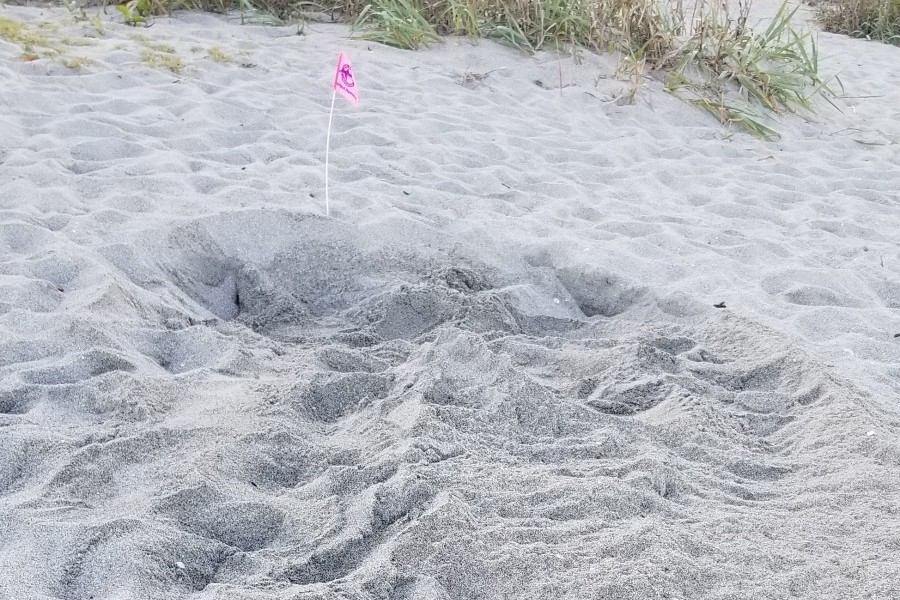Earth Day 2021: Sea Turtles Arrive in Sarasota
It’s official, the first sea turtles have landed on the shores of Sarasota County, just in time for Earth Day. Mote Marine Laboratory & Aquarium’s Sea Turtle Conservation & Research Program (STCRP) documented the first nest of the season today, April 22, 2021. The nest is located in Venice, just north of the public Venice Beach area.
Mote began monitoring Sarasota area beaches on April 15, and volunteers saw the telltale signs of a nest during their patrol early Thursday morning. A crawl was seen leading from the water up to a nest, and other clues in the sand were used to identify the nest itself and the species that created the nest. Volunteers Peg Magee and Joyce Thompson responded to the reports to confirm the nest and place stakes to mark the nest. Magee and Thompson are seasoned volunteers, beginning their 14th and 12th years, respectively, patrolling local beaches.
The nest was created by a loggerhead sea turtle, Sarasota's most abundant nester. Sarasota County is home to the densest loggerhead sea turtle nesting in the Gulf of Mexico. Green sea turtles nest on area beaches as well, often arriving later in the season, and although relatively low in number, STCRP has documented an increase in green sea turtle nests in Sarasota in the last 20 years. Other signs of sea turtles locally also include a loggerhead false crawl—where a female comes onto the beach and leaves without creating a nest—the day before on Siesta Key.
“Once again, sea turtles have arrived on our beaches a little bit before the official start of season,” said Melissa Bernhard, Mote Senior Biologist and Conservation Manager. “We’re looking forward to another successful season for sea turtles. We’ve seen incredible growth in nesting locally in the last decade, and we hope to see these threatened animals continue to increase their numbers.”
Mote’s 35th annual Run for the Turtles event, virtual this year, is also underway. Participants can run, walk or crawl from anywhere in the world, now through June 30th, to support Mote’s sea turtle monitoring efforts. Information and registration is available at runsignup.com/Race/FL/Sarasota/RunfortheTurtles.
More information about Mote's sea turtle nest monitoring:
- Approximately 300 volunteers assist Mote's team of biologists and interns with daily monitoring of beaches, ranging in age from 10 to 85 years old
- 35 miles of beaches monitored, from Longboat Key through Venice
- 2021 is Mote’s 40th year of sea turtle monitoring
- In 2020, Mote documented 3,716 nests. The previous year, 2019, was a record-breaking year with 5,112 nests
- The top-five years for number of sea turtle nests in the Sarasota region have occurred in the last five years
- Follow weekly nesting numbers at mote.org/pages/2021-sea-turtle-nesting
- Nesting season in this region is officially May 1 - Oct. 31. Please consult all applicable laws and ordinances that may be in your area. Consult FWC's website for information about ordinances that may apply to you
- Sea turtles, sea turtle eggs and nesting marking materials are protected under state and federal law and any harassment or interference with a sea turtle, living or dead, is subject to penalty
- Mote's sea turtle activities are conducted under Florida Fish and Wildlife Conservation Commission Marine Turtle Permits 027, 054, 070, 048, and 028.
With the arrival of sea turtles, it’s important that members of the public enjoy the beaches while being mindful of nesting sea turtles. A list of tips and best practices are below, and Bernhard adds, “The best way to remember how to help turtles is to think to yourself, ‘am I leaving the beach as natural and undisturbed as possible?’”
How to protect sea turtles when you’re on land and on the water:
- Shield or turn off outdoor lights that are visible on the beach from May through October.
- Close drapes after dark and put beach furniture far back from the water.
- Fill in holes that may entrap hatchlings on their way to the water.
- Do not approach nesting turtles or hatchlings, make noise, shine lights at turtles, or use flashlights, cell phone lights, or fishing lamps on the beach.
- Do not encourage a turtle to move while nesting or pick up hatchlings that have emerged and are heading for the water.
- Do not use fireworks on the beach.
- Follow Coast Guard-approved safe boating guidelines and use vigilance to avoid striking sea turtles and other large marine life.
- Be sure to stow trash and line when under way. Marine debris that accidentally blows overboard or out of a truck can become ingested by or entangled around marine life.
- Wear polarized sunglasses to better see marine life in your path.
- If you encounter injured or sick sea turtles, DO NOT attempt to assist the animal on your own. Call trained responders at the contact information below.
- If you see a sick, injured or stranded sea turtle in Sarasota or Manatee county waters, contact Mote Marine Laboratory’s Stranding Investigations Program at 888-345-2335.
- Outside of Sarasota or Manatee counties, please call the Florida Fish and Wildlife Conservation Commission (FWC) at 888-404-FWCC (3922).
- If you suspect that someone is tampering with a sea turtle nest, harassing a sea turtle or has possession of a sea turtle or any of its parts, please call FWC or your local law enforcement agency.
- If you find sea turtle hatchlings that are not on the beach or are headed away from the ocean, call FWC’s hotline at 888-404-FWCC (3922). Hatchlings heading towards the ocean should be left alone.
